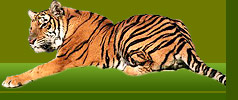The Sloth Bears
Latin name : Melursus
Ursinus
Local name : Bhalu & Rinch (Hindi), Asval
(Marathi), Karadi (Tamil & Kannadee), Puni Karadi & Elugubanti
(Malayalam) Elugubanti (Telugu)
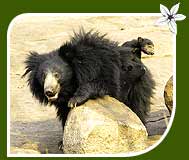
The
Sloth Bear is a hard working animal, you can spot them in lowlands forests
in all over India. They can be sighted in the dense forested tracts India
from Himalayas to down South. It is a medium sized nocturnal animal covered
in long shaggy, black coat with a white crescent of hair on the chest. It
stands 65 to 85 cm at shoulder and weigh 127 to 145 kg. They have a long
snout with bare lips and a lack of upper incisors. The front feet are bowed
and the forefeet are turned inward.
The sloth bears are known for their habit of deep slumbers. They reside
inside the covers of dense forests till late sun set and come out in the
evening and eats termites, fruits, insects, eggs, birds, flowers, tubers,
grains, meat and is very fond of drinking honey. They can run more faster
than human being. They mate in hot weather. They can be seen Ranthambhore,
Corbett, Dudhwa, Manas, Bandipur, Nagarhole.
The Wolf
Latin name : Canis lupus
(Linnaeus)
Local Name : Bheriya, Hundar & Huryar (Hindi),
Landga (Marathi), Thola & Vraka (Kannada), Thodelu (Telugu) Onai (Tamil)
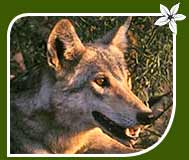
The
Indian Wolf also called as the Indian Gray Wolf, is a semi-desert-adapted
wolf and can be spotted all across of the Indian states including Gujarat,
Rajasthan, Haryana, Uttar Pradesh, Madhya Pradesh, Maharashtra, Karnataka
and Andhra Pradesh. Defamed for shrewdness and tendencies of attack on
children, this Indian wolf is about 65 to 75 cm in height and weigh about 18
to 27 km. It have sandy a fawn coat stippled with black. The Himalayan wolf
is larger and heavier than others and wears a blackish coat.
The Indian Wolf has tremendous capability to adapt. In the snow-capped
hills, they live in caves, holes and inside the rocks while in the desert,
wolves take shelter in burrows dug in the sand dunes. They hunt cattle,
black buck, haes and any animal and bird. Occasionally, they also carry off
the children and attack on human being. Their breeding take place in the
month of October.
The Nilgai
Latin name : Boselaphus
tragocamelus (Pallas)
Local Name : Nil, Nilgai, Roz & Rojra (Hindi),
Rohu & Nilgai (Marathi)
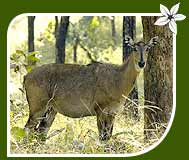
The
Nilgai is one of the most frequently seen wild animals of northern India. It
measures 1.2 to 1.5 m at the shoulder and are 1.8 to 2 m long and has 40 to
45 cm tail. The average mature Nilgai weigh 120 to 240 kg and babies are
13.6 to 15.9 kg. In build, Nilgai is like horse. It has thin legs and a
robust body that slopes down from the shoulder. They have two small conical
horns on the head and an erectile mane on the back of the neck and a strip
of hair the middle of the throat. The females are yellow-brown while males
gradually darken to a grey-blue as they reach maturity.
The Nilgai can easily be spotted the plain areas of north India. It is
found only in the Indian peninsula from the base of the Himalayas to
Karnataka. They are also seen in the border areas of the Rajasthan. They
live in the herd that ranges from 30 to 100 animals and depend on grasses,
leaves, buds, and fruit. They has a very excellent speed of running and can
manage without water for a long period.
The Musk Deer
Latin name : Moschus
Moschiferus (Linnaens)
Local Name : Kastura & Mushk (Hindi), Raos &
Roan (Kashmir)
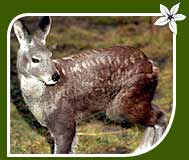
Beautiful
and seductive, the musk deer is a small deer species that stands 50cm at the
shoulder. Originally it is an intermediate specie between the deer and the
antelope and regarded as under developed form of deer. Dark brown in colour,
hornless, a peculiar tail, this innocent animal is alway on risk of the
poaching. The male deer have 3 to 4 grams of musk which is obtained from the
musk gland beneath the skin of the abdomen. This musk helps female deer
during mating. For this great value and importance in the international
market, Musk deer are highly threatened and on the target of poachers and
criminals.
Musk deer are generally found in the high altitudes of the Himalayas and
berch forests. For their protection, they dig a shallow pit in which they
lie concealed and come out in morning and evening to fee. Mainly they eat
grass lichens, and flowers. They are frequently spotted in Chamba, Kinnaur
and Shimla of Himachal Pradesh, Jammu & Kashmir, Sikkim and Nepal
states. It breeds in January and the young deer is born in the last week of
June or early July.



 The
Sloth Bear is a hard working animal, you can spot them in lowlands forests
in all over India. They can be sighted in the dense forested tracts India
from Himalayas to down South. It is a medium sized nocturnal animal covered
in long shaggy, black coat with a white crescent of hair on the chest. It
stands 65 to 85 cm at shoulder and weigh 127 to 145 kg. They have a long
snout with bare lips and a lack of upper incisors. The front feet are bowed
and the forefeet are turned inward.
The
Sloth Bear is a hard working animal, you can spot them in lowlands forests
in all over India. They can be sighted in the dense forested tracts India
from Himalayas to down South. It is a medium sized nocturnal animal covered
in long shaggy, black coat with a white crescent of hair on the chest. It
stands 65 to 85 cm at shoulder and weigh 127 to 145 kg. They have a long
snout with bare lips and a lack of upper incisors. The front feet are bowed
and the forefeet are turned inward.  The
Indian Wolf also called as the Indian Gray Wolf, is a semi-desert-adapted
wolf and can be spotted all across of the Indian states including Gujarat,
Rajasthan, Haryana, Uttar Pradesh, Madhya Pradesh, Maharashtra, Karnataka
and Andhra Pradesh. Defamed for shrewdness and tendencies of attack on
children, this Indian wolf is about 65 to 75 cm in height and weigh about 18
to 27 km. It have sandy a fawn coat stippled with black. The Himalayan wolf
is larger and heavier than others and wears a blackish coat.
The
Indian Wolf also called as the Indian Gray Wolf, is a semi-desert-adapted
wolf and can be spotted all across of the Indian states including Gujarat,
Rajasthan, Haryana, Uttar Pradesh, Madhya Pradesh, Maharashtra, Karnataka
and Andhra Pradesh. Defamed for shrewdness and tendencies of attack on
children, this Indian wolf is about 65 to 75 cm in height and weigh about 18
to 27 km. It have sandy a fawn coat stippled with black. The Himalayan wolf
is larger and heavier than others and wears a blackish coat.  The
Nilgai is one of the most frequently seen wild animals of northern India. It
measures 1.2 to 1.5 m at the shoulder and are 1.8 to 2 m long and has 40 to
45 cm tail. The average mature Nilgai weigh 120 to 240 kg and babies are
13.6 to 15.9 kg. In build, Nilgai is like horse. It has thin legs and a
robust body that slopes down from the shoulder. They have two small conical
horns on the head and an erectile mane on the back of the neck and a strip
of hair the middle of the throat. The females are yellow-brown while males
gradually darken to a grey-blue as they reach maturity.
The
Nilgai is one of the most frequently seen wild animals of northern India. It
measures 1.2 to 1.5 m at the shoulder and are 1.8 to 2 m long and has 40 to
45 cm tail. The average mature Nilgai weigh 120 to 240 kg and babies are
13.6 to 15.9 kg. In build, Nilgai is like horse. It has thin legs and a
robust body that slopes down from the shoulder. They have two small conical
horns on the head and an erectile mane on the back of the neck and a strip
of hair the middle of the throat. The females are yellow-brown while males
gradually darken to a grey-blue as they reach maturity.  Beautiful
and seductive, the musk deer is a small deer species that stands 50cm at the
shoulder. Originally it is an intermediate specie between the deer and the
antelope and regarded as under developed form of deer. Dark brown in colour,
hornless, a peculiar tail, this innocent animal is alway on risk of the
poaching. The male deer have 3 to 4 grams of musk which is obtained from the
musk gland beneath the skin of the abdomen. This musk helps female deer
during mating. For this great value and importance in the international
market, Musk deer are highly threatened and on the target of poachers and
criminals.
Beautiful
and seductive, the musk deer is a small deer species that stands 50cm at the
shoulder. Originally it is an intermediate specie between the deer and the
antelope and regarded as under developed form of deer. Dark brown in colour,
hornless, a peculiar tail, this innocent animal is alway on risk of the
poaching. The male deer have 3 to 4 grams of musk which is obtained from the
musk gland beneath the skin of the abdomen. This musk helps female deer
during mating. For this great value and importance in the international
market, Musk deer are highly threatened and on the target of poachers and
criminals. 